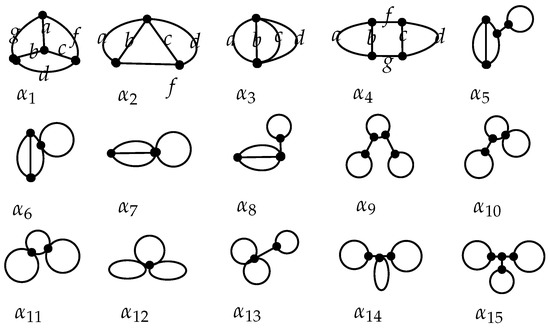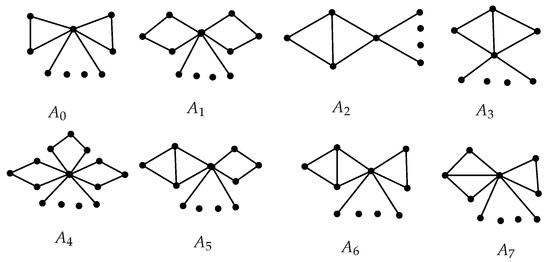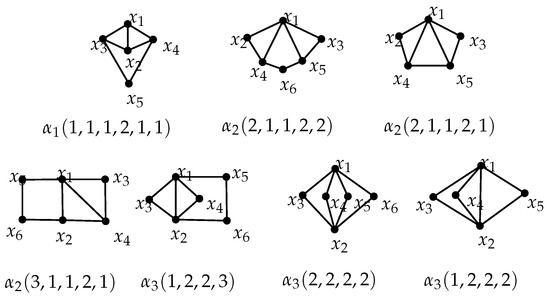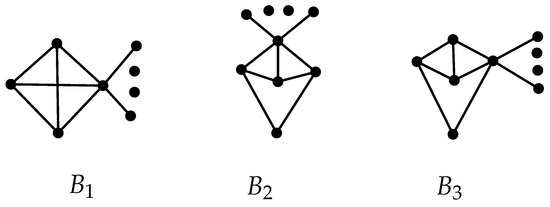Abstract
For a given graph G, is the revised edge-Szeged index of G, where and are the number of edges of G lying closer to vertex u than to vertex v and the number of edges of G lying closer to vertex v than to vertex u, respectively, and is the number of edges equidistant to u and v. In this paper, we identify the lower bound of the revised edge-Szeged index among all tricyclic graphs and also characterize the extremal structure of graphs that attain the bound.
MSC:
05C92; 05C12; 05C35; 05C38; 05C75; 05C76
1. Introduction
All graphs considered in this paper are finite, undirected, and simple. The molecular topological index is constructed from the molecular graph mapping, which has applications in physics, chemistry, and network theory. There are relationships between topological indices and some physical properties or some chemical properties. There are nearly a thousand kinds of topological indices that have been proposed since the Wiener index appeared in 1947. The Wiener index is one of the most important chemical topological indexes. For , denotes the distance between u and v in G. The Wiener index of graph G is defined as follows:
It has been extensively studied, see [1,2,3,4]. The properties and applications of topological indices have been reported in [5,6,7,8,9,10,11,12,13,14,15,16]. Let be an edge of G and define three subsets of as follows:
Evidently, consists of a partition of vertices set V(G) with respect to e. The number of vertices of are denoted by , respectively. Note that for . In particular, G is bipartite implies that holds for each edge ; so, .
When T is a tree, the Wiener index has the following formula
Motivated by the above formula, Gutman produced a new graph invariant named the Szeged index and defined it by
where G is an arbitrary graph, not necessarily connected. Randić discovered that Gutman did not consider the contributions of these vertices, which are equidistant to u and v. Thus, he conceived a correctional version of the Szeged index and named it the revised Szeged index. The revised Szeged index of a connected graph G is defined as
In addition, for a connected graph G, it is well known that .
Let an edge ; the distance between the edge e and the vertex x, denoted by , is defined as . Similarly, is the set of edges equidistant from u and v, is the set of edges whose distance to vertex u is smaller than the distance to vertex v, and is the set of edges closer to v than u. The number of edges of are marked as , respectively. Thus, the edge-Szeged index [17] and the revised edge-Szeged index [18] of G are defined below:
The results of the edge-Szeged index can be found in [19,20,21,22]. In [7,10,18], the authors determined the maximum values regarding the revised edge-Szeged index for unicyclic graphs, bicyclic graphs, and tricyclic graphs, respectively. In addition, Ref. [9] determined unicyclic graphs with the minimum value of the revised edge-Szeged index. Ref. [23] identified those graphs having the minimum value of the revised edge-Szeged index among all bicyclic graphs. Motivated by these results, we study the revised edge-Szeged index on tricyclic graphs. In this paper, we obtain a lower bound of the revised edge-Szeged index for connected tricyclic graphs.
2. Preliminaries
In the section, we will present some notations and results. If a graph H is obtained by getting rid of as many pendants of G as possible, we say that H is the brace of G. All braces of tricyclic graphs are shown in Figure 1. Let be the set of tricyclic graphs of order m and be the set whose element contains as its brace for . Clearly, . For convenience, let . We call an edge a pendant edge if and . is the graph obtained by fusing two vertices as a new vertex from and , respectively, and name it w. w is the fusing vertex of G. Clearly, w is a cut vertex of G. For every , w belongs to one of the three sets . Since every path from to each vertex in is via w, all edges of must be contained in one of the three sets (they are similar to w). Therefore, the contribution of to the item completely relies on the number of the edges in ; in other words, changing the structure of cannot alter the value of .

Figure 1.
The braces in .
Dong et al. [18] acquired the lower bound of the revised edge-Szeged index among all unicyclic graphs with size m.
Theorem 1.
Suppose G is a unicyclic graph with size m. Then,
with equality, if and only if for , , for , and for .
Soon after, Liu et al. [23] showed the lower bound of bicyclic graphs with the revised edge-Szeged index.
Theorem 2.
Let G be a connected bicyclic graph with size m. Then,
In this paper, for tricyclic graphs, the minimum value of is determined.
Theorem 3.
Let G be a connected tricyclic graph of size m. Then,
By , we have an equivalent formula of the revised edge-Szeged index.
For brevity, let . Equation (1) is rewritten as
Based on the property of pendant edge, we have the following two elementary results. Graphs are shown in Figure 2.

Figure 2.
The graphs are used in Theorem 2 and Theorem 3.
Lemma 1.
Let . Then,
with equality, if and only if e is a pendant edge.
Lemma 2.
Let be a connected graph of size m. Then,
where the fusing vertex of is the center vertex of .
3. Lower Bound of on
In this section, we identify a lower bound of on . Before listing the proof, some preparations are necessary. The next conclusion holds due to Theorem 1.
Lemma 3.
Let be a connected graph and be a unicyclic graph with , and . Then, for , for , and for , where the fusing vertex of is the center vertex of .
By means of Theorem 2 and the above result, the next two conclusions are obtained. Note that the fusing vertex of is the center vertex of .
Lemma 4.
Let G be a tricyclic graph on order and H be a bicyclic graph on order . If . Then for and equality holds only if , for and equality holds only if .
Lemma 5.
Let G be a tricyclic graph on order and H be a bicyclic graph on order . If , then for with equality, only if , and for with equality, only if . In particular, for .
We now exhibit the proof of Lemma 5.
Proof.
Assume that . by Theorem 2. The fusing vertex of is the center of , and we have
In the same way, we obtain for . □
Theorem 4.
Let with m edges. Then, for , for , for , and for . In particular, for .
Proof.
Suppose G belongs to , and it contains some as its brace. It is clear to find a vertex such that with and , where is a bicyclic subgraph of G, and is an unicyclic subgraph of G. By means of Lemma 3, we have for , and for . In particular, for .
For , from Lemma 5, we deduce that
, and for .
Thus, we deduce that by for .
For , Lemma 4 results in
Thus, the proof is finished. □
4. Lower Bound of on
In this section, we will present the lower bound of on . If , then, it has a subgraph . Obviously, is 2-connected. In view of Equation (2), in order to determine the minimum , it is sufficient to to ensure is as large as possible. Thus, we assume that the all vertices of G outside its brace are pendant edges. Let with edge sets and , respectively. From Equation (2), . For the sake of brevity, let . Before showing the main result of the section, we need some preparation. Graphs are shown in Figure 3.

Figure 3.
Labeling the vertices of some braces.
Lemma 6.
Suppose G is a tricyclic graph and contains a brace . Then, for , and for . Moreover, .
Proof.
Suppose with a brace . Let be the five vertices of , as shown in Figure 3, and be the number of pendants connecting to . Assume that , let be the graph obtained from by deleting the pendant vertices of and and adding them to and , respectively. We hence have
Let be the graph from by shifting the pendant vertices of to . Then, we deduce that
If , let be the graph obtained from by switching pendant vertices from to . Thus, we verify that
Hence, the result holds. □
Graphs are shown in Figure 4.

Figure 4.
The graphs used in Lemma 6 and Theorem 5.
Lemma 7.
Suppose G includes the brace . Then, with equality only if . Moreover, .
Proof.
Let with a brace . Label the six vertices , as shown in Figure 3. denotes the number of pendant vertices connecting to for . Let denote the graph obtained from by deleting the pendant vertices of and and adding them to . If , let denote the graph obtained from by moving the pendant vertices of and to and , respectively. Thus, we obtain
For , denotes the graph from by switching all pendant vertices from to . So, we have
The above three relations with Equation (2) infer that . Clearly, , and Hence, we finish the proof. □
Graphs are shown in Figure 5.

Figure 5.
The graphs used in Lemmas 7–9 and Theorem 6.
Lemma 8.
If G has the brace , then , and .
Proof.
Suppose with a brace . The six vertices of are labeled as , see Figure 3. Let denote the number of pendent vertices connecting to . For , the new graph is from by attaching pendant vertices to from . It is deduced that
For , let denote the graph from by shifting the pendant vertices from and to and , respectively. We deduce that
Now, assume that , and . Let be the graph obtained from by transferring all pendant vertices from and to .
The above relations together with Equation (2) imply that Observe that , and
Consequently, the proof is obtained. □
Lemma 9.
If G includes a brace , then for , for , and for . Moreover, .
Proof.
Suppose with a brace . We label the five vertices of as (see, Figure 3) and denote the number of pendant vertices connecting to . Assume that by symmetry, let denote the graph obtained from by shifting the pendant vertices from and to and , respectively. We obtain
For , let be the graph obtained from by deleting pendant vertices of and adding them to . Then, we arrive at
For , , let be the graph obtained from by moving the pendant vertices from to . Thus, we obtain
For , , let be the graph obtained from by shifting the pendant vertices from to . We deduce that
Hence, the result holds. □
Lemma 10.
If G has a brace , then with equality only if . Furthermore, .
Proof.
Suppose with a brace . denote the six vertices of with and for , see Figure 3. Let be the number of pendant vertices connecting to . Assume that by symmetry. For , let denote the graph, which is obtained from G by deleting all pendant vertices of and adding them to . Thus, we verify that
For , let be the graph obtained from by shifting the pendant vertices from to . Then, we have that
The two relations with Equation (2) result in , and . Furthermore,
Thus, we complete the proof. □
Graphs are shown in Figure 6.

Figure 6.
The graphs used in Lemmas 10–12 and Theorem 7.
Lemma 11.
Suppose G contains a brace . Then, for , and for , for . In addition, .
Proof.
Suppose with a brace . We label the vertices of as with and for and denote the number of pendant vertices connecting to . Assume that by symmetry. For , let denote the graph obtained from by shifting the pendant vertices from to . Thus, we obtain
For , let be the graph obtained from by shifting the pendant vertices from to . Then, we have
Note that for , , and for , . Assume that , . is the graph from by switching the pendant vertics from to . Then, we have
The above relations, combined with Equation (2), infer that . Observe that . Furthermore, we deduce that
Hence, the conclusion holds. □
Lemma 12.
Suppose G includes the subgraph . Then .
Proof.
Suppose with a brace . We label the vertices of as with and for . denotes the number of pendant vertices connecting to . Assume that , and let denote the graph from by transferring the pendant vertices from to . From the two graphs, we deduce that
For , let be the graph obtained from by deleting the pendant vertices of and adding them to . We deduce that
Combining Equation (2) and the above two relations, we infer that and . Clearly,
Hence, the proof is complete. □
Graphs are shown in Figure 7.

Figure 7.
Labeling some edges in the four braces .
Theorem 5.
Let with m edges. Wee have for , and for .
Proof.
Suppose ; then, G has brace , as shown in Figure 2. In order to deduce the conclusion, it is sufficient to show from Equation (2).
Case 1. has at least three paths with lengths no less than 2.
Subcase 1.1 The three paths enclose a cycle. Assume that the three paths are and by the symmetry of . Choose the nine edges , see Figure 7, and count the value of the nine edges, respectively. Evidently, they are no less than . It follows that .
Subcase 1.2 The three paths consist of a new path. Assume that the three paths are and by the symmetry of . Choose the nine edges , see Figure 7. Thus, we deduce that .
Subcase 1.3 The three paths share a common vertex. Assume that the three paths are and by the symmetry of . Choose the nine edges , see Figure 7, and count the value of the nine edges. In fact, they are no less than , which brings about .
Case 2. contains just two paths with lengths no less than 2.
Subcase 2.1 The two paths belong to the same cycle in . Assume that the two paths are by the symmetry of . Choose eight edges , see Figure 7, and count the of these edges. Thus, we obtain .
Subcase 2.2 The two paths belong to two distinct cycles in .
In the same way as subcase 2.1, we also verify that .
Case 3. just possesses one path with length no less than 2.
By symmetry, assume the path is with . We claim that (If not, , we obtain ). It follows from Lemma 6 that (or )
Case 4. The six paths with length one.
Notice that . Denote its vertices as and the number of ’s pendant vertices. Let be the graph from by shifting the pendant vertices from the other three vertices to . We obtain By Equation (2), In addition, for , and otherwise. □
Theorem 6.
Let with m edges. Then, .
Proof.
Suppose , which implies G has the subgraph as its brace. For symmetry, assume that . From Equation (2), it is sufficient to confirm that . We will divide the process into four cases to verify the conclusion.
Case 1.
Subcase 1.1. Selecting nine edges in , see Figure 7, we deduce that .
Subcase 1.2. At least one of is more than 1. If , we choose 10 edges , as shown in Figure 7, and deduce .
If , choose 10 edges , see Figure 7. Thus, we verify that .
Case 2., .
Subcase 2.1., , and . We choose 9 edges , as shown in Figure 7, and count of these edges. Thus, we have .
Subcase 2.2., and The subcase is confirmed by Lemma 6.
Subcase 2.3, and at least one of is more than 1. The proof of Subcase 2.3 is similar to Subcase 2.1.
Case 3..
Subcase 3.1. At least one of three numbers is more than one. If (or ), we choose (see Figure 7) and deduce that .
If , we choose (see Figure 7) and show that . If , Lemma 8 means that .
Subcase 3.2 .
Applying Lemma 9, we have .
Thus, we confirm the conclusion. □
Theorem 7.
Let with m edges. Then, .
Proof.
Since , then there is some as its brace. Without loss of generality, suppose . We now divide this into three cases to show the result.
Case 1..
Choose the 12 edges (see Figure 7). We deduce that .
Case 2..
Subcase 2.1.. We choose the 11 edges (see Figure 7) and show that .
Subcase 2.2.. The subcase can be verified by Lemma 10.
Case 3.
Subcase 3.1.. We deduce that , through selecting the 10 edges (see Figure 7) in and figuring out their .
Subcase 3.2.. The proof of Subcase 3.2 is similar to that of Subcase 3.1. So, the process is omitted here.
Subcase 3.3.. If , we choose 9 edges (see Figure 7) in and count of these edges. We deduce that ). We now assume that . The assertion holds from Lemma 12.
Subcase 3.4..
The subcase is verified through Lemma 11.
Together with the above discussion, we complete the proof. □
Theorem 8.
Let with m edges. Then, .
Proof.
Theorems 4–8 imply Theorem 3.
5. Conclusions
The upper bound of the revised edge-Szeged index on tricyclic graphs was obtained by Liu et al. [7]. This work motivated us to further research these graphs to obtain a sharp lower bound and thereby characterize all graphs that meet the bound with the utilization of the graph operation and asymmetry of graphs. The result completes the extremal value study of tricyclic graphs and enriches the conclusions on the revised edge-Szeged index.
Author Contributions
All authors contriuted to the paper. All authors have read and agreed to the published version of the manuscript.
Funding
Shengjin Ji and Tongkun Qu are supported by Shandong Provincial Natural Science Foundation of China (No. ZR2019MA012).
Institutional Review Board Statement
Not applicable.
Informed Consent Statement
Not applicable.
Data Availability Statement
Not applicable.
Acknowledgments
The authors thank the reviewers for providing helpful comments and suggestions to improve this paper.
Conflicts of Interest
The authors declare no conflict of interest.
References
- Dobrynin, A.; Entringer, R.; Gutman, I. Wienner index of trees: Theory and applications. Acta Appl. Math. 2001, 66, 211–249. [Google Scholar] [CrossRef]
- Gutman, I.; Klavžar, S.; Mohar, B. Fifty Years of the Winner Index. MATCH Commun. Math. Comput. Chem. 1997, 35, 1–259. [Google Scholar]
- Gutman, I.; Yeh, Y.; Lee, S.; Luo, Y. Some recent results in the theory of the Winner number. Indian J. Chem. 1993, 32A, 651–661. [Google Scholar]
- Wiener, H. Structural determination of paraffin boiling points. J. Am. Chem. Soc. 1947, 69, 17–20. [Google Scholar] [CrossRef] [PubMed]
- Aouchiche, M.; Hansen, P. On a conjecture about the Szeged index. Eur. J. Combin. 2010, 31, 1662–1666. [Google Scholar] [CrossRef]
- Azari, M. Some variants of the Szeged index under rooted product of graphs. Miskolc Math. Notes 2016, 17, 761–775. [Google Scholar] [CrossRef]
- Chen, L.; Li, X.; Liu, M. Tricyclic graphs with maximal revised Szeged index. Discr. Appl. Math. 2014, 177, 71–79. [Google Scholar] [CrossRef]
- Hobiny, A.; Alzahrani, F.; Abbas, I.; Marin, M. The effect of fractional time derivative of bioheat model in skin tissue induced to laser irradiation. Symmetry 2020, 12, 602. [Google Scholar] [CrossRef]
- Khadikar, P.; Karmarkar, S.; Agrawal, V.; Singh, J.; Shrivastava, A.; Lukovits, I.; Diudea, M. Szeged index-Applications for drug modeling. Lett. Drug Des. Disc. 2005, 2, 606–624. [Google Scholar] [CrossRef]
- Li, X.; Liu, M. Bicyclic graphs with maximal revised Szeged index. Discr. Appl. Math. 2013, 161, 2527–2531. [Google Scholar] [CrossRef]
- Marin, M.; Othman, M.; Abbas, I. An Extension of the Domain of Influence Theorem for Generalized Thermoelasticity of Anisotropic Material with Voids. J. Comput. Theor. Nanosci. 2015, 12, 1594–1598. [Google Scholar] [CrossRef]
- Pisanski, T.; Randič, M. Use of the Szeged index and the revised Szeged index for measuring network bipartivity. Discr. Appl. Math. 2010, 158, 1936–1944. [Google Scholar] [CrossRef]
- Simić, S.; Gutman, I.; Baltić, V. Some graphs with extremal Szeged index. Math. Slovaca 2000, 50, 1–15. [Google Scholar]
- Wang, S. On extremal cacti with respect to the Szeged index. Appl. Math. Comput. 2017, 309, 85–92. [Google Scholar] [CrossRef]
- Xing, R.; Zhou, B. On the revised Szeged index. Discr. Appl. Math. 2011, 159, 69–78. [Google Scholar] [CrossRef][Green Version]
- Žerovnik, J. Szeged index of symmetric graphs. J. Chem. Inf. Comput. Sci. 1999, 39, 77–80. [Google Scholar] [CrossRef]
- Gutman, I.; Ashrafi, A. The edge version of the Szeged index. Croat. Chem. Acta 2008, 81, 263–266. [Google Scholar]
- Dong, H.; Zhou, B.; Trinajstić, C. A novel version of the edge-Szeged index. Croat. Chem. Acta 2011, 84, 543–545. [Google Scholar] [CrossRef]
- Cai, X.; Zhou, B. Edge Szeged index of Unicyclic graphs. MATCH Commun. Math. Comput. Chem. 2010, 63, 133–144. [Google Scholar]
- Khalifeh, M.; Yousefi-Azari, H.; Ashrafi, A.; Gutman, I. The edge Szeged index of product graphs. Croat. Chem. Acta 2008, 81, 277–281. [Google Scholar]
- Tranik, N. The edge-Szeged index and the PI index of benzenoid systems in linear time. MATCH Commun. Math. Comput. Chem. 2017, 77, 393–406. [Google Scholar]
- Vukičević, D. Note on the graphs with the greatest edge Szeged index. MATCH Commun. Math. Comput. Chem. 2009, 61, 673–681. [Google Scholar]
- Liu, M.; Ji, S. Bicyclic graphs with minimal revised edge Szeged index. 2022; submitted. [Google Scholar]
Publisher’s Note: MDPI stays neutral with regard to jurisdictional claims in published maps and institutional affiliations. |
© 2022 by the authors. Licensee MDPI, Basel, Switzerland. This article is an open access article distributed under the terms and conditions of the Creative Commons Attribution (CC BY) license (https://creativecommons.org/licenses/by/4.0/).